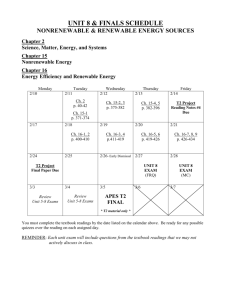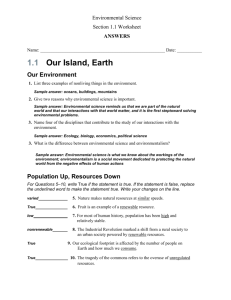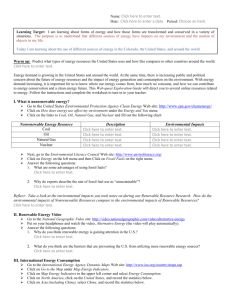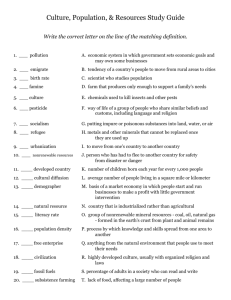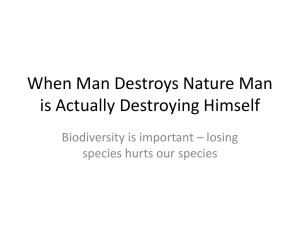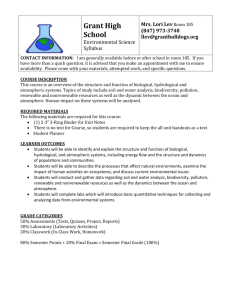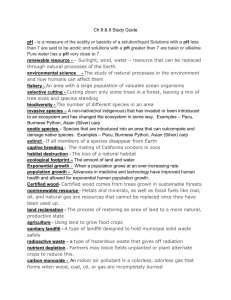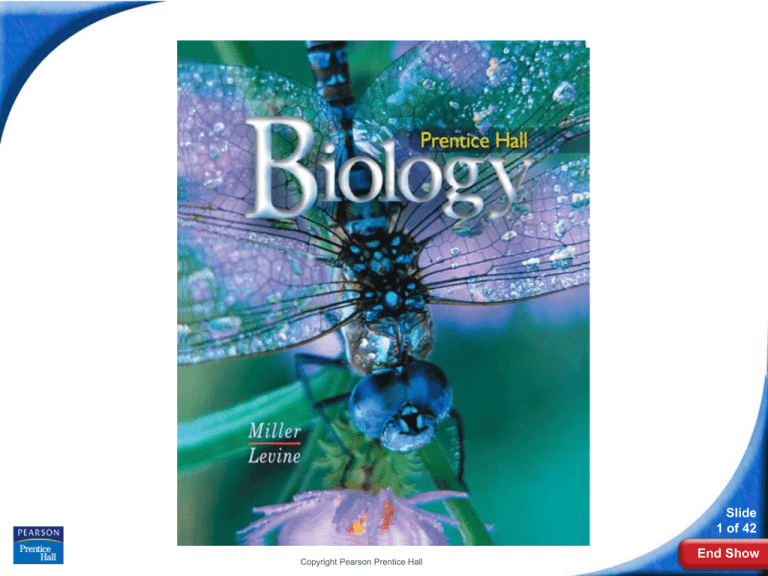
Biology
Slide
1 of 42
Copyright Pearson Prentice Hall
End Show
6-2 Renewable and
Nonrenewable Resources
Slide
2 of 42
Copyright Pearson Prentice Hall
End Show
6-2 Renewable and Nonrenewable
Resources
Classifying Resources
How are environmental resources
classified?
Slide
3 of 42
Copyright Pearson Prentice Hall
End Show
6-2 Renewable and Nonrenewable
Resources
Classifying Resources
Classifying Resources
Environmental goods and services may
be classified as either renewable or
nonrenewable.
Slide
4 of 42
Copyright Pearson Prentice Hall
End Show
6-2 Renewable and Nonrenewable
Resources
Classifying Resources
Renewable resources can regenerate if they are
alive, or can be replenished by biochemical cycles if
they are nonliving.
A tree is an example of a renewable resource
because a new tree can be planted in place of an old
tree that dies or is cut down.
Slide
5 of 42
Copyright Pearson Prentice Hall
End Show
6-2 Renewable and Nonrenewable
Resources
Classifying Resources
A nonrenewable resource is one that cannot be
replenished by natural processes.
Fossil fuels such as coal, oil, and natural gas are
nonrenewable resources. Once these fuels are
depleted, they are gone forever.
Slide
6 of 42
Copyright Pearson Prentice Hall
End Show
6-2 Renewable and Nonrenewable
Resources
Sustainable Development
What effects do human activities have on
natural resources?
Slide
7 of 42
Copyright Pearson Prentice Hall
End Show
6-2 Renewable and Nonrenewable
Resources
Sustainable Development
Human activities can affect the quality
and supply of renewable resources such
as land, forests, fisheries, air, and fresh
water.
Slide
8 of 42
Copyright Pearson Prentice Hall
End Show
6-2 Renewable and Nonrenewable
Resources
Sustainable Development
Sustainable Development
Sustainable development is a way of using
natural resources without depleting them, and of
providing for human needs without causing longterm environmental harm.
Slide
9 of 42
Copyright Pearson Prentice Hall
End Show
6-2 Renewable and Nonrenewable
Resources
Land Resources
Land Resources
Land provides space for human communities and
raw materials for industry. Land also includes the
soils in which crops are grown.
If managed properly, soil is a renewable resource.
Slide
10 of 42
Copyright Pearson Prentice Hall
End Show
6-2 Renewable and Nonrenewable
Resources
Land Resources
Food crops grow best in fertile soil—a mixture of
sand, clay, rock particles, and humus (material from
decayed organisms).
Slide
11 of 42
Copyright Pearson Prentice Hall
End Show
6-2 Renewable and Nonrenewable
Resources
Land Resources
Soil erosion is the wearing away of surface soil by
water and wind.
Plowing the land removes the roots that hold the soil
in place, and therefore increases the rate of soil
erosion.
Slide
12 of 42
Copyright Pearson Prentice Hall
End Show
6-2 Renewable and Nonrenewable
Resources
Land Resources
Desertification is the process by which productive
areas are turned into deserts.
Desertification is caused by a combination of farming,
overgrazing, and drought.
Slide
13 of 42
Copyright Pearson Prentice Hall
End Show
6-2 Renewable and Nonrenewable
Resources
Land Resources
A variety of sustainable-development practices can
prevent problems such as soil erosion and
desertification.
Slide
14 of 42
Copyright Pearson Prentice Hall
End Show
6-2 Renewable and Nonrenewable
Resources
Land Resources
Sustainable-development practices include:
• contour plowing—fields are plowed across the
slope of the land to reduce erosion
• leaving stems and roots of the previous year's
crop in place to help hold the soil
• planting a field with rye rather than leaving it
unprotected from erosion
Slide
15 of 42
Copyright Pearson Prentice Hall
End Show
6-2 Renewable and Nonrenewable
Resources
Forest Resources
Forest Resources
Earth’s forests are an important resource for the
products they provide and for the ecological
functions they perform.
Slide
16 of 42
Copyright Pearson Prentice Hall
End Show
6-2 Renewable and Nonrenewable
Resources
Forest Resources
Forests:
• provide wood for products and fuel.
• remove carbon dioxide and produce oxygen.
• store nutrients.
• provide habitats and food for organisms.
• moderate climate.
• limit soil erosion.
• protect freshwater supplies.
Slide
17 of 42
Copyright Pearson Prentice Hall
End Show
6-2 Renewable and Nonrenewable
Resources
Forest Resources
Whether a forest can be considered a renewable
resource depends partly on the type of forest.
Temperate forests of the Northeast are renewable
because they have been logged and have grown
back naturally.
Old-growth forests, such as those in Alaska and the
Pacific Northwest, are nonrenewable because it
takes centuries to produce them.
Slide
18 of 42
Copyright Pearson Prentice Hall
End Show
6-2 Renewable and Nonrenewable
Resources
Forest Resources
Deforestation
Loss of forests, or deforestation, has several
effects:
• Erosion can wash away nutrients in the topsoil.
• Grazing or plowing can permanently change
local soils and microclimates, which prevents
the regrowth of trees.
Slide
19 of 42
Copyright Pearson Prentice Hall
End Show
6-2 Renewable and Nonrenewable
Resources
Forest Resources
Forest Management
Mature trees can be harvested selectively to
promote the growth of younger trees and preserve
the forest ecosystem.
Tree geneticists are breeding new, faster-growing
trees that produce high-quality wood.
Slide
20 of 42
Copyright Pearson Prentice Hall
End Show
6-2 Renewable and Nonrenewable
Resources
Fishery Resources
Fishery Resources
Fishes and other animals that live in water are a
valuable source of food.
Slide
21 of 42
Copyright Pearson Prentice Hall
End Show
6-2 Renewable and Nonrenewable
Resources
Fishery Resources
Overfishing
Overfishing, or harvesting fish faster than they can
be replaced by reproduction, has greatly reduced
the amount of fish in parts of the world’s oceans.
Until recently, fisheries seemed to be a renewable
resource, but overfishing has limited that resource.
Slide
22 of 42
Copyright Pearson Prentice Hall
End Show
6-2 Renewable and Nonrenewable
Resources
Fishery Resources
Sustainable Development
The U.S. National Marine Fisheries Service has
issued guidelines that specify how many fish, and
of what size, can be caught in various parts of the
oceans.
The regulations have helped fish populations
recover.
Slide
23 of 42
Copyright Pearson Prentice Hall
End Show
6-2 Renewable and Nonrenewable
Resources
Fishery Resources
Slide
24 of 42
Copyright Pearson Prentice Hall
End Show
6-2 Renewable and Nonrenewable
Resources
Fishery Resources
Slide
25 of 42
Copyright Pearson Prentice Hall
End Show
6-2 Renewable and Nonrenewable
Resources
Fishery Resources
Aquaculture
The raising of aquatic animals for human
consumption, which is called aquaculture, is also
helping to sustain fish resources.
Slide
26 of 42
Copyright Pearson Prentice Hall
End Show
6-2 Renewable and Nonrenewable
Resources
Air Resources
Air Resources
The condition of the air affects people’s health.
Smog is a mixture of chemicals that occurs as a
gray-brown haze in the atmosphere.
Smog is:
• due to automobile exhausts and industrial
emissions.
• considered a pollutant because it threatens
people’s health.
Slide
27 of 42
Copyright Pearson Prentice Hall
End Show
6-2 Renewable and Nonrenewable
Resources
Air Resources
A pollutant is a harmful material that can enter the
biosphere through the land, air, or water.
The burning of fossil fuels can release pollutants that
cause smog and other problems in the atmosphere.
Slide
28 of 42
Copyright Pearson Prentice Hall
End Show
6-2 Renewable and Nonrenewable
Resources
Air Resources
Strict automobile emissions standards and clean-air
regulations have improved air quality in many cities,
but air pollution is still a problem.
Slide
29 of 42
Copyright Pearson Prentice Hall
End Show
6-2 Renewable and Nonrenewable
Resources
Air Resources
Many combustion processes release nitrogen and
sulfur compounds into the atmosphere.
These compounds combine with water vapor to form
acid rain.
Slide
30 of 42
Copyright Pearson Prentice Hall
End Show
6-2 Renewable and Nonrenewable
Resources
Air Resources
Formation of Acid Rain
Chemical Transformation
Condensation
Nitric acid
Sulfuric acid
Emissions to Atmosphere
Dry Fallout
Nitrogen oxides
Sulfur dioxide
Industry
Transportation
Precipitation
Particulates Acid rain, fog,
Gases
snow, and mist
Ore
smelting
Power
generation
Slide
31 of 35
Copyright Pearson Prentice Hall
End Show
6-2 Renewable and Nonrenewable
Resources
Air Resources
Acid rain kills plants by damaging their leaves and
changing the chemistry of soils and standing-water
ecosystems.
Acid rain may dissolve and releases toxic elements,
such as mercury, from the soil, freeing the elements
to enter other portions of the biosphere.
Slide
32 of 42
Copyright Pearson Prentice Hall
End Show
6-2 Renewable and Nonrenewable
Resources
Freshwater Resources
Freshwater Resources
Americans use billions of liters of fresh water daily
for everything from drinking and washing to
watering crops and making steel.
Although water is a renewable resource, the total
supply of fresh water is limited and is threatened
by pollution.
Slide
33 of 42
Copyright Pearson Prentice Hall
End Show
6-2 Renewable and Nonrenewable
Resources
Forest Resources
Sources of pollution include:
• improperly discarded chemicals that enter
streams and rivers.
• wastes discarded on land that seep through soil
and enter underground water supplies.
• domestic sewage containing compounds that
encourage growth of algae and bacteria.
• sewage containing microorganisms that spread
disease.
Slide
34 of 42
Copyright Pearson Prentice Hall
End Show
6-2 Renewable and Nonrenewable
Resources
Freshwater Resources
Sustainable Use of Water
One way to ensure the sustainable use of water is
to protect the natural systems involved in the water
cycle that help purify water.
These include:
• wetlands
• forests
• other vegetation
Slide
35 of 42
Copyright Pearson Prentice Hall
End Show
6-2 Renewable and Nonrenewable
Resources
Freshwater Resources
Also, by conserving water in:
• home
• industry
• agriculture
Slide
36 of 42
Copyright Pearson Prentice Hall
End Show
6-2
Click to Launch:
Continue to:
- or -
Slide
37 of 42
End Show
Copyright Pearson Prentice Hall
6-2
Which of the following is a nonrenewable
resource?
a. trees
b. grasses used by grazing animals
c. oxygen in the air
d. fossil fuels
Slide
38 of 42
End Show
Copyright Pearson Prentice Hall
6-2
Which of the following is a sustainable-use
strategy that can help prevent desertification?
a. contour plowing
b. protecting wetlands
c. aquaculture
d. selective harvesting of trees
Slide
39 of 42
End Show
Copyright Pearson Prentice Hall
6-2
The advantage of sustainable development is
that it
a. provides for human needs without depleting
natural resources.
b. produces additional fossil fuels.
c. protects wildlife from hunters and other
threats.
d. is a natural process that regulates itself.
Slide
40 of 42
End Show
Copyright Pearson Prentice Hall
6-2
A mixture of chemicals that occurs as a haze in
the atmosphere is known as
a. smog.
b. acid rain.
c. particulates.
d. fog.
Slide
41 of 42
End Show
Copyright Pearson Prentice Hall
6-2
Plowing the land removes the roots that hold the
soil in place and increases the rate of
a. pollution.
b. soil erosion.
c. deforestation.
d. soil formation.
Slide
42 of 42
End Show
Copyright Pearson Prentice Hall
END OF SECTION

